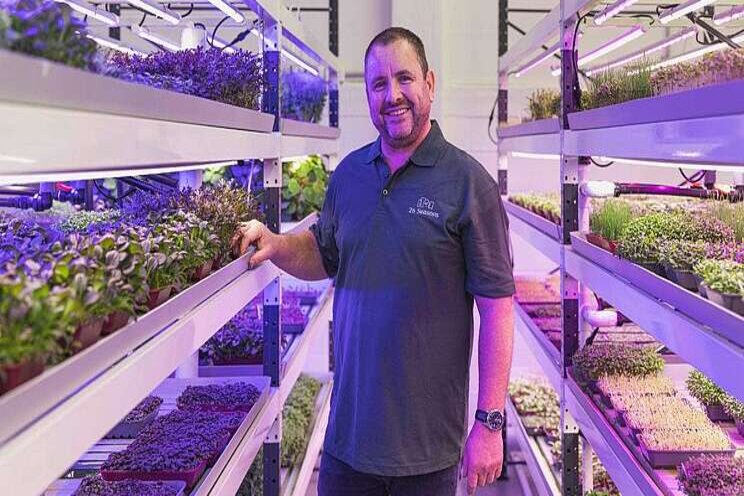The future of farming could be up, not out
Added on 31 August 2021

Click here to watch the short video.
Keltie's? business 26 Seasons? first farmed microgreens in vertical farms in a former Wellington nightclub, but has recently expanded his operation to Auckland.
Vertical farming grows food on vertical surfaces, unlike traditional farming which produces on a single level such as in a field or a greenhouse.
But Keltie? said it was not just about stacking plants on top of each other, but using technology to farm smarter.
"The point of vertical farming is to have a really controlled environment. You control the atmosphere, the watering, the light and the nutrients. To stack plants vertically is just one way of doing it. The crucial element is that ability to control," Keltie? said.
Keltie? said 26 Seasons was a technology company that happened to farm, and technology was helping to greatly increase the yield of its crop.
According to data from indoor farm provider Plantlab, a vertical lettuce farm operating at full capacity achieved a yield of 80kg to 120kg crop yield per square metre, while a traditional farm achieved a yield of 3kg to 9kg per square metre.

SUPPLIED
26 Seasons co-founder Matt Keltie says the controlled environment offered by a vertical farming system could be a game-changer for New Zealand horticulture.
The opportunity offered by vertical farming has come at the right time, Keltie? said.
"Traditional farming and the land conversion it requires can contribute to excess carbon. When you combine that with the urban sprawl, and the decreasing amount of appropriate agricultural land you see there is a need there to work smarter," Keltie? said.
Dr Clive Cornford?, former associate dean of primary industries at Manukau Institute of Technology and now an independent consultant for the horticulture industry, said the industry should not ignore the potential of vertical farming.

SUPPLIED
Clive Cornford believes vertical farming could bring on a new breed of entrepreneurs into the local horticulture industry.
"This is a way of expanding our horticultural activity, rather than replacing it. The advantages are you can grow wherever you want, and you can grow all year round," Cornford? said.
Cornford? pointed to major food production in Singapore, the United Arab Emirates, China, Europe and the USA all utilising vertical farming technology to prove it is a major presence on the global stage.
"While we don't have the same pressures of adverse climate, or cities of 5 million plus in New Zealand that shouldn't stop us from actively exploring and investing into vertical farming," Cornford? said.
Kylie Horomia? is the head of industry transformation at WayBeyond?, a company that builds AI technology for the global agriculture industry. Horomia? said the biggest export offering in the sector was the digital technology used to run the systems.

SUPPLIED
Kylie Horomia, head of industry transformation at WayBeyond, says while there is innovation in New Zealand horticulture, there is a danger the country could fall behind when it comes to new technology.
"The term digital farming is more apt here. It is that ability to use the data to determine your next move," Horomia? said.
The systems built by Waybeyond? can increase crop yield prediction to 90 per cent to 95 per cent accuracy six weeks out from harvest, and is used in major food producers in places like the US, Canada, and Mexico.
But no one is yet utilising this homegrown technology in New Zealand, and Horomia? believes there is a danger local agriculture will be left behind.
"If we were climbing Mt Everest, Waybeyond? and our clients are at base camp two or three, and New Zealand are back at base camp one," Horomia? said.
Because New Zealand had access to land, water and sunshine hours there was little impetus to try something new, Horomia? said.
"Sometimes people operate on an 'if it ain't broke, don't fix it mentality'. But we have a huge amount of innovation in New Zealand, and all of that knowledge and technology is being exported. I think we are on the verge of being left behind," Horomia? said.
Plant & Food Research? is looking into the potential of urban horticulture.
Samantha Baldwin?, direction leader on the project, said vertical farming technology offered New Zealand horticulture more choices.
"It can extend growing seasons, it can extend the type of crops we can grow, it also gives options to groups in society who may not have as easy access to fresh produce. And as land as impacted by climate change this will become increasingly important," Baldwin? said.

SUPPLIED
Samantha Baldwin, direction leader at Plant & Food Research said the knowledge gained in practices like vertical farming can go on to benefit the entire industry.
"We can use this tech to move from an economy that only exports the final product, to a place where we can actually export the growing system that produces the product," Baldwin? said.
"The knowledge we gain from developing indoor farming technology can be applied to the entire covered crop industry. This is a real opportunity to look at things from a completely different perspective."
Source and Photo Courtesy of Stuff
Source: Stuff
More news















